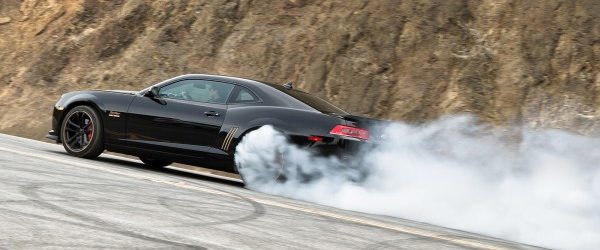Up in smoke
 I was just sitting at a stoplight, minding my own business. My car (affectionately dubbed “The Batmobile”) idling with its spot-on impersonation of an offshore boat’s low burble. I was yakking away on Bluetooth with my Las Vegas staff when a familiar LED scowl appeared in my rearview. It was the intimidating smirk of a certain tungsten-colored Stingray. As it pulled up alongside me, its signature throaty staccato, growing louder as the secondary exhaust valves opened, indicated what was about to happen.
I was just sitting at a stoplight, minding my own business. My car (affectionately dubbed “The Batmobile”) idling with its spot-on impersonation of an offshore boat’s low burble. I was yakking away on Bluetooth with my Las Vegas staff when a familiar LED scowl appeared in my rearview. It was the intimidating smirk of a certain tungsten-colored Stingray. As it pulled up alongside me, its signature throaty staccato, growing louder as the secondary exhaust valves opened, indicated what was about to happen.
“Hang on guys,” I told my team, “My boss just pulled up alongside me — and it’s ON.”
With no time to hang up the call — let alone find that elusive launch control button — the light turned green. To my left, the Corvette lurched forward like a jackrabbit while I dropped the clutch and pinned it. Nearly 600 supercharged ponies transformed the Batmobile’s confident growl into an angry war cry, while the Goodyear Eagles transformed into a white cloud.
I went nowhere.
“Crap crap crap!” I’m yelling, among other exclamations, with my Vegas team still patiently listening in. I grabbed second gear, fishtailing to the right; electronic traction control losing its struggle against the V8’s fury. The Vette kept it’s lead, pulling a car length ahead as I counter steered and reached for third. By the time everything gathered up and I started to gain, the race was lost.
You’ve probably already figured out how a car with less power, less torque, less rubber and an automatic transmission beat me: He went from A to B, I went up in smoke.

Every drag racer knows: displacement, horsepower, torque, turbos, nitrous, you name it — they don’t mean squat. Applying that power in a measured, productive way is what wins the race.
To summarize: Winning does not come from power. Winning comes from successful application of power.
A lighter vehicle with less horsepower – but the ability to efficiently transfer force into forward motion – will beat a larger, more powerful one every time. That’s the physics lesson learned at the stoplight.
So how does this humiliating tale apply to the dealership? Simple: in the workplace, “power” is defined as energy, effort, work and intensity. But we should also look at power in another way – in business, power is influence. And in many respects, success depends upon the successful application of influence; applying power in a measured, productive way to achieve result.
For an employee, that means managing his/her day toward focused execution of predetermined, deliberate and specific tasks that move toward tactical goals. The entry-level folks tend to get real busy putting out fires, expending a lot of energy — reacting to issues rather than managing organized priorities — and often feel like they are unproductive, hence the term “spinning my wheels.” The key here is control: don’t ignore the urgent fires thrown your way, but control your efforts by prioritizing what must be done in what order; a holistically managed checklist. That list will always grow, so it must be constantly reshuffled based on priority, urgency, and timeliness. Mastering task lists is the key to productivity, and it’s more difficult than it appears. Without tangible forward motion, the staffer literally “burns out” – roasting their tires and going nowhere.
The highly-effective employee is like a hot hatchback — lacking horsepower but using dynamic agility to more effectively maneuver their workplace — leveraging momentum, influence and efficiency to get things done.
For the owner or senior manager, it’s all about measured application of their prodigious power. As I learned from my impromptu drag race, pure muscle doesn’t necessarily get you from A to B fastest. As a leader, you’re already the supercharged V8 muscle car – you’ve nothing to prove. Yelling, threatening and condescending is equivalent to a loud, smoky burnout. It might bring temporary satisfaction, but accomplishes nothing – unless you count destroying expensive tires.
Leaders want to inspire, not bully – but frustration with subordinates’ inability to change behavior manifests itself in the harsh reactions we’ve all been guilty of. So like a powerful car, we must ease back on the throttle, feather the clutch, and let our tires (the team) catch up with torque (our personal drive). Once your staff is on the same page, the potential for rapid acceleration is unleashed. It’s difficult and requires a ton of restraint, but don’t dump that clutch until you’ve got traction. You aren’t forcing your will; you’re influencing others to move. Gently push, drive, and apply pressure. Once your machine is unified with solid grip, stomp the gas and hang on.

Control, influence and measured application of power. That’s the key to forward motion. Avoid burnout, and you’ll get to the finish line quicker.
In the meantime: does anybody know where I can get a deal on some Goodyear Eagle F1’s?
Ride Drive On,
-CC
Chris Clovis has had the honor and pleasure of 26 years in the powersports industry, currently serving as vice president of EagleRider Motorcycles [www.eaglerider.com]. Chris’ opinions are his own, and do not necessarily reflect those of his employer, publisher or clients. Chris has vowed a rematch with his boss, Chris McIntyre, as soon as he can figure-out how to activate the Batmobile’s launch control feature.









Hey McIntyre, I would have expected a better ride than what you’ve got. I’m disappointed.